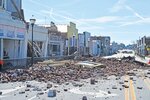
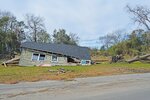

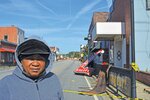

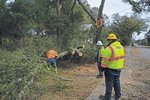
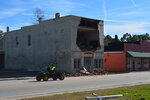
Standing next to his son amidst a pile of wood, insulation and broken glass two days after a tornado leveled his property, Joel Rutland is thinking something similar to others in the town of Bamberg: “it’s a mess.”
“I don’t know what we’ll do here, I have no idea,” said Rutland. “Everything was destroyed, but I’m still here. Me and my boy are still here.”
In only two minutes, a tornado swept through the town of Bamberg on the afternoon of January 9, flattening buildings, bringing down trees and spraying debris across the town. The destruction was part of a larger storm system that swept across the southeast that contained the perfect tornado ingredients: hot air and low pressure.
Since the tornado struck, a section of Highway 301 between Heritage Highway and Elm Street has been taped off and full of debris, first responders, reporters and small business owners assessing the tornado’s damage.
Although nobody was physically hurt, a number of businesses and homes were destroyed, changing the lives of locals like Rutland.
Tornado path and destruction
The tornado's first touchdown was at Oak to Barrel, a small business on the south side of Bamberg that manufactures bourbon and wine barrels and opened in 2021. The business’s general manager, David Hutto, was inside the building at the time the tornado struck.
“Once the glass shattered, I just kinda darted to the back corner and hunkered down,” said Hutto, who was physically unhurt. “I watched everything else as it got ripped off.”
On Wednesday, January 10, the National Weather Service (NWS) announced that the tornado had brought winds of 125 miles per hour. It registered as a 2 on the Enhanced Fujita Scale, a system that rates a tornado's wind speeds on a scale of 0–5, with 5 being the highest.
“It’s a lot to take in and try to figure out what we’re gonna do,” said Hutto, looking at the destruction the morning after the tornado struck. “We have a lot of clean-up to do, a lot of rebuilding to do. … This was my home away from home.”
The tornado continued its path northward, sweeping through Bamberg’s southern neighborhood, where Walnut Street resident Andrea Rahn and her three kids were taking shelter. Part of a magnolia tree fell through their roof, although Rahn and her kids were unharmed.
“It sounded like it does in the movies: a freight train,” Rahn said as her family began cleaning up the morning after the storm. “Just as soon as it came through, it went away. I was scared, I couldn’t even think.”
Virgie Bamberg, a Calhoun Street resident whose home was in the path of the tornado, said she sheltered in her closet while the tornado raged outside.
“The sound was crazy,” Bamberg said. “It was so strong. It was a scary thing, something I’d never felt before.”
After touching down over a residential area, the tornado continued northward, sweeping through Bamberg’s main street, where many of the town’s historical brick buildings were destroyed or heavily damaged. Video released by the South Carolina Emergency Management Division shows the moment at which the tornado brought down buildings on Main Street.
Mary Johnson, who goes by Ms. Scarlett, is the owner of Scarlett’s Banquet Hall, a historic theater on Main Street that she says has been in Bamberg since the early 1900s. Ms. Scarlett had just recently gotten the theater’s sign renovated when amid the tornado's wrath, the sign fell into the street.
“We lost that as well,” Ms. Scarlett said. “I don’t know if these buildings can be fixed.”
When Coty Jameson, an owner of a bar on Main Street, showed up to his bar on the morning of January 10, he discovered that the roof of his bar had collapsed, and the inside was flooded.
“We was doing some work on the inside and the building as a whole to get it up to date and get it to look better,” said Jameson. “I don’t really know where we stand now. I’m confused. I don’t know what to do next.”
South Carolina has historically had weather patterns that create tornado conditions; Between 1990 and 2017, the South Carolina State Climatology Office recorded an average of 26 tornadoes per year. However, as climate modeling technology improves, scientists are able to determine the extent to which global climate change influences extreme weather events.
Jana Houser, associate professor of meteorology at Ohio State University, said although the storm system that caused the tornado was not exclusively caused by climate change, Earth’s rapid heating is influencing storms in the southeast. This heating is caused by human activities, mainly burning fossil fuels, according to decades of climate change research.
“We’re living in a time where we’re experiencing changes in our climate system,” said Houser. “Out of the entire country there is the most robust signal for increases in severe weather activity in the southeast, particularly over the wintertime months. Who really thinks they’re going to be impacted by a tornado in January? But that is exactly the time of year when we’re seeing the most dramatic evidence of changes in the climate.”
Response efforts
Within minutes of the tornado’s destruction, first responders were on the scene. In Barnwell County, where the storm only brought down a handful of trees, first responders went to Bamberg to assist in disaster recovery.
“We were very fortunate [in Barnwell],” said Roger Riley, the director of Emergency Management for Barnwell County. “We took about 20 firemen to Bamberg. … That's what we do in emergency management is help those who were affected when we were not affected. We were there within 30 minutes of their tornado.”
Missy Cato was one of the Barnwell County firefighters who responded to help with the search and rescue efforts.
“It is a miracle that no one was hurt during this horrible storm,” said Cato on Facebook. “Prayers for those who lost their homes and businesses. Praying that they can get back to some normalcy very soon.”
Crews from the South Carolina Baptist Disaster Relief also responded to lend a helping hand. On January 10, the Midlands chainsaw unit took a tree off the roof of the home of a first responder who had worked all night in the wake of the tornado. The Barnwell-Bamberg chainsaw unit also responded.
Outside of fire departments and disaster response teams, others offered their hand in helping clean up. Mike Baldwin, a local contractor, offered free clean up services to any residents.
“Everybody was very appreciative,” Baldwin said. “My pastor and another person came out to help. We’re like-minded people, just out here to help others.”
Recovery
The recovery process from any natural disaster can take years and affects all people differently. Joel Rutland, whose property was across the street from Oak to Barrel was uninsured, estimates that he lost $100,000 in the tornado.
The Federal Emergency Management Agency (FEMA) has not declared a disaster zone in Bamberg. Currently, Bamberg County is encouraging residents and business owners to file insurance claims and report damage to county services. Bamberg County’s public information officer, Alisha Moore, said that after the county gets a total cost of the damages the tornado caused, it can apply for FEMA dollars.
“We are asking residents and business owners to ensure that they file those insurance claims [to] get a total number as far as what their damages look like,” Moore said. “Collectively, as a county, as a city, we can apply for those disaster recovery programs.”
The county is also asking for those without insurance to report their damages, Moore said. However, for Rutland and Jameson, the lack of guaranteed long-term support beyond help from first responders makes their path to recovery uncertain.
“I haven’t had one soul contact me,” Rutland said two days after the tornado, referring to disaster agencies. “I guess because I’m a poor man. I’m a poor person so nobody gives a crap.”
In the days following the tornado, The People-Sentinel interviewed locals like Rutland who expressed shock, frustration and despair at the state of the town. These feelings are common in communities following a natural disaster, according to Mark Snyder, a disaster psychiatrist who leads the call center of the American Red Cross.
“Helplessness and powerlessness, it’s a common feeling,” said Snyder. “One of the important things that we can do when we are faced with this kind of trauma is to allow ourselves to feel the way we feel.”
As the community continues its recovery, The People-Sentinel will continue to provide updates.